HTC Vive
First launched in 2016, the HTC Vive was one of the earliest premium VR headsets available to consumers. And, for a long time afterwards, it was the king of consumer VR tech.
That’s because, for a good few years, it felt far ahead of many of its competitors. This made it difficult to describe the experience of stepping into virtual reality to someone who hadn’t already tried VR themselves. Even those who had had a taste of VR back in 2016 were likely only experiencing it via the cheaper mobile VR hardware like the Gear VR, Google Daydream View or Google Cardboard, which served as a great gateway into VR, but couldn’t be compared to what you’d experience with an HTC Vive strapped to your face.
Fast-forward to 2021 and a lot has changed. Now, there are multiple VR headset options you could buy right now, from the super high-end experience of the Valve Index (if you can find one) through to the best option for PlayStation lovers, the PSVR and the standalone, extremely convenient Oculus Quest and, more recently, the Oculus Quest 2.

Since the launch of this original HTC Vive, HTC has also launched a number of new VR headsets, including the HTC Vive Cosmos and HTC Vive Cosmos Elite.
What’s more, there’s likely to be an upgrade to the HTC Vive we’re reviewing here right around the corner. A top HTC official said the company plans on producing a new wireless, standalone VR headset in 2021 that is “probably better than what’s out there from any vendor today”. Although it doesn’t seem to be a direct competitor to the likes of the Oculus Quest 2, it could still signal a shift in focus for HTC to create a more mainstream VR headset.
Virtual reality might not yet be as popular as playing on a regular games console is, but more and more people are buying VR systems for their homes – or at least trying them out at a friend’s house.
But that doesn’t mean to say that the original HTC Vive we’re reviewing here isn’t still a solid option for starting your VR journey – it’s just worth considering it’s a good few years older than some of the newer models entering the market.
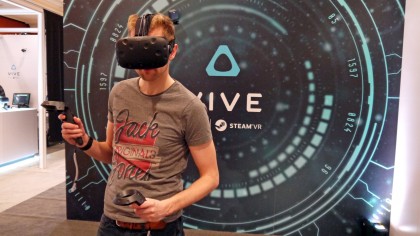
The HTC Vive wasn't affordable for most people at launch, or for a long time after, but year on year it’s got less expensive.
As of right now, you can no longer officially buy the HTC Vive system through HTC, the brand is focusing on its newer headsets. However, it is still available from third-party sellers and some tech retailers.
At the time of writing, the whole system, which includes the headset, the controllers, earbuds and the base stations themselves, sells for about $499 / £499 (about AU$615). This still isn’t cheap considering that's before you buy a computer with the recommended specs – which you’ll absolutely need to get the HTC Vive up and running, it isn’t a standalone headset like the Oculus Quest or Quest 2.
It also isn't cheap when you look more widely at the VR landscape. It's still about $100 / £100 more expensive than the Oculus Quest 2, which is the current VR headset favorite and our most-recommended option – especially those without the powerful PC set-up who want a quick, convenient and comfortable way to try VR out for the first time.
Below you'll find our original review of the HTC Vive, as well as thoughts about the VR system throughout now we're looking back at it nearly five years after it first launched.
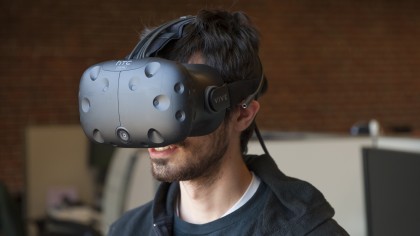
How does the HTC Vive work?
The first time we got our hands on the HTC Vive was all the way back at Mobile World Congress 2015, where HTC made the original announcement of its partnership with Valve – and it's worth noting that it's been retooled and vastly improved since that original showing.
The consumer version works wonderfully, is vastly easier to setup and feels ready to be shipped to the public which, considering that units are supposed to go out any day now, is a very good thing.
Like other virtual reality headsets, the Vive has the arduous task of completely immersing you in a video game by producing two images simultaneously. However, unlike PlayStation VR and Oculus Rift that use a single camera to track your head and extremities, HTC Vive has two base stations, which sit on the wall attached to the included wall mounts or a high shelf and help map track your movements as you walk around in the 3D world.
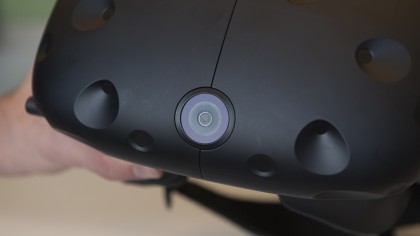
What the stations track are small divots on the top of the two controllers and on the headset itself. There are 72 of these dots speckling the controllers and helmet that help accurately track the Vive.
Inside every box is a Vive headset unit, two controllers, two base stations, earbuds, a cloth to wipe down the lenses, a small hub that sits between the headset and your PC, charging cords for the controllers and power cables for base stations. Also packaged with every unit are three games: Job Simulator, Fantastic Contraption and The Lab. It's everything you're going to need for a great virtual reality experience minus the computer that powers the whole thing.
New to the consumer version is a spectacularly simple setup program that should, for the vast majority of tech enthusiasts, allow you to breeze through the setup process.
Once you're plugged in and the room has been mapped out, you're free to roam around every inch of the digital space. This means digital worlds can be more expansive and more immersive on the Vive than the other two systems and, thankfully, less nausea-inducing, too.
The only limitations you'll encounter once inside your digital world are faint blue walls made up of lines that keep you inside the playzone. These blue lines are superimposed into your game by SteamVR, the software put out by Valve that's running underneath every virtual experience.
It's called "chaperone mode," and its practical application is to prevent you from moving too far outside the area that you've set up for the Vive and potentially stumbling into furniture/plants/animals/etc around your home and hurting yourself.
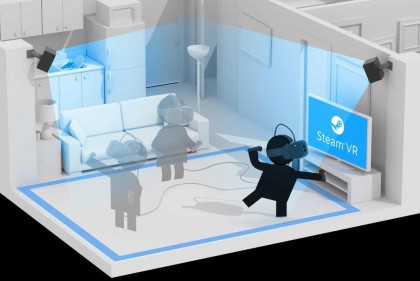
As for the games themselves, what's there is simply amazing.
In the course of two weeks, I've played 20 or so titles, some of which are much, much better than others. I'll cover them in detail in a moment but, in short, they were mostly fantastic showcases for VR, full of personality and just as varied as you might expect. One minute I was on top of a castle fending off stickman invaders with a bow and arrow, the next I was inside of an arcade cabinet fighting spaceships in three dimensions. I played mini-golf on an impossibly constructed multi-level course and trained to become both a ninja and space pirate.
Some of what I just described is part of Valve's The Lab, a collection of games that the iconic developer put together to introduce players to virtual reality. These are all very good titles, but third-party developers have now caught up and are releasing some very decent VR games too.
The finished iteration of the HTC Vive is best described as a bulbous visor taken straight from the pages of a science fiction novel. It's heavier (and therefore a bit less comfortable) than both the Oculus Rift or PlayStation VR, but the additional weight isn't something you notice once you're fully immersed in Vive's brave new world.
The headset is supported by three velcro straps that wrap around the top and sides of the Vive and meet in the back to form a cradle for your noggin. This cradle keeps the Vive from falling off or slipping too far left or right. And while they do a fair job of preventing major malfunctions, the straps are arguably the least user-friendly part of the Vive. Adjusting them while the headset is on is a difficult endeavor, and getting an exact fit takes a bit of trial and error. But, once you finally find a position that feels right, all that's left to do is turn the knob located on the right side of the headset to increase/decrease the focal length of the lens to reduce blurriness.
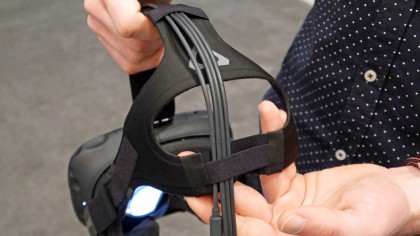
Three cords go from the top of the headset to a small hub that connects the visor to your computer. HTC has now got around to launching a wireless adapter to cut those cords, but the Vive isn't wireless out of the box – and the new adapter is another $299 / £299 on top of what you've already spent.
Thankfully the cords are at least neatly bundled together which means you only need to avoid one large, 15-foot cable instead of three separate smaller ones. From the small gray hub, you'll need to run one cord to a USB 2.0 port on your computer, another cord to an open HDMI port (something you might struggle with if you use the HDMI port on your PC for your monitor) and one power cable to an open outlet.
Like the Oculus Rift, the HTC Vive allows you to use your own headphones instead of forcing a pair on you. I picked a pair of Creative Sound Blaster H5s due to their padding and excellent sound quality, but the Vive welcomes anything from a pair of high-end Sennheisers to cheap earbuds.
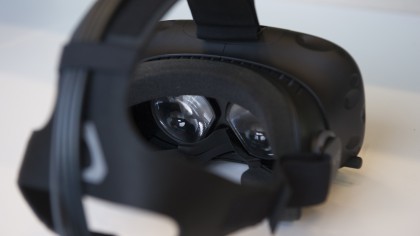
Inside the headset is a 2160 x 1200 OLED screen that runs at 90Hz. For comparison, that's slightly less than the PlayStation VR's 120Hz refresh rate, but because the Vive is running off a more powerful GPU, it's not exactly comparing apples to apples. You can expect a 110-degree field of view, which is one of the largest available on any virtual reality headset and results in a more immersive experience.
The base stations, which are crucial to mapping the playspace and tracking you as you move about the room, should sit on a nearby wall or high shelf in order to do their job to the best of their ability. The latest version of the stations are smaller, wireless and make a dull hum that's almost inaudible unless you're standing right next to them. A minor annoyance I found is that the power cables for the base stations are a bit short, which in the end forced me to re-arrange my living room in order to place the IR cameras closer to an outlet.
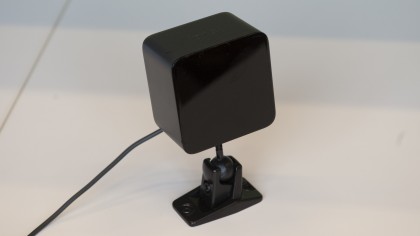
Similarly the controllers are also much more versatile compared to the competition, giving developers many more tools to work with. Each controller has a clickable touchpad and a rear trigger that has two stages to allow for more refined interaction. While they're a bit bigger in stature than the Oculus Touch or PlayStation Move, the Vive's controllers function exponentially better than either.
The main buttons you'll need to familiarize yourself with are start and connect buttons located above and below the touchpad, two side buttons that can be pushed with your ring finger and the palm of your hand and the trigger on the back.
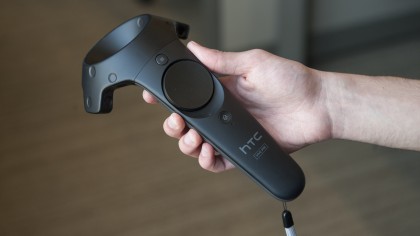
Moving around in-game might take a combination of pressing a trigger and the touchpad, using a trigger to jump from spot to spot, or physically walking from one part of the room to the other, depending on the title. While the Oculus Rift can track a playspace of around 5 x 11 feet and the PlayStation VR can spot you in an area of around 8 x 6 feet, the HTC Vive has a maximum tracking area of 15 x 15 feet. It's a substantial difference and one that takes VR from a sedentary experience to a truly immersive one.
Vive is not only immersive, but also strangely social thanks to an additional window that pops up on your monitor whenever SteamVR is active: it shows onlookers exactly what you're seeing in-game. I found this incredibly helpful when guiding my friends through games for the first time or for the times when I wanted my friends to see what I was seeing in VR.
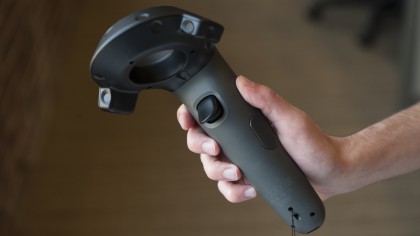
Performance
So far I've used words like "immersive," "amazing" and "best headset on the market, bar none" when describing the HTC Vive. I could rant for pages and pages how much I've enjoyed my time with the headset but, without trying it for yourself, it's tough to fully appreciate just how close to perfect this technology is.
While other systems lag behind your movements or have a noticeable delay, the Vive can intelligently track exactly where you are in the room and what you're doing with your hands. That sounds like it should be a given, but you wouldn't believe how many demos I've tried where the system just couldn't figure out where I was standing or how I was holding my arms.
When you don't get one-to-one tracking, it's an absolute nightmare for your brain, creating a sort of cognitive dissonance that makes you feel both nauseated and unnatural. Now sure, there were one or two points during my two-week odyssey that things didn't go exactly right (I nearly vomited while playing a poorly rendered dungeon crawler), but those times were far fewer here than on the comparable hardware from Oculus or PlayStation.

The games and demos you'll experience on the HTC Vive range in levity, from casual, low-stress romps, to crazy firefights, to surgeon simulators and horror titles. Pulling off such a range without causing severe motion sickness is no mean feat, but the HTC Vive carries it off well.
Of course the number of games on offer has come a long way since the HTC Vive launched with a mere 49 titles to its name. More and more games are arriving on SteamVR all the time, and most of them are of a very good quality.
With all these games, it's a major boon for the system that switching between games takes seconds. To move from one game to the next, all you need to do is press the system button to pull up the SteamVR interface and then select another title to load up.
These are some of the experiences – both demos and games – I tried during my first two weeks on the HTC Vive, to give some context as to what I experienced:

The Lab: Best described as the Hello World of virtual reality, The Lab is a collection of demos developed by Valve that serve as an introduction to Vive's brave new world. Included in The Lab are four games that put you on a scenic, photorealistic mountainside; in the middle of Aperture's warehouse with a massive mechanical ballista; on the precipice of a castle; and inside a 3D version of Galaga.

Audio Shield: Audio Shield is a deceivingly simple game. First, pick any audio file from your music library. Then, once the beat starts, block the incoming colored projectiles with the color-coordinated shield in time with the music. It's Dance Central meets 300 in a very weird, but totally enjoyable music mash-up.

Vanishing Realm: Rite of Steel: Vanishing Realm fulfills the quota of one fantasy title needed to release any new system. In it, you're tasked to explore a cave and fight off the magical undead minions that have overrun the joint. Along the way you'll find swords, bows and arrows and wands galore that will help you get the job done.

Water Bears VR: I'm a sucker for a good puzzle game. Water Bears is best described as the virtual reality equivalent of Where's My Water? In it, you'll be asked to direct streams of colored water to similarly colored globes that contain the eponymous aquatic ursines. Direct the water to the right bubbles and the miniature creatures will bust out of their liquid prisons.
While 99% of my experience with the Vive has been an incredible look at the capabilities of virtual reality, there are some parts of the Vive VR experience that aren't as great as you'd hope – for one, there's still that damn wire connecting you to your high-end PC (unless you buy the wireless adapter), and it's easy to trip over it when you forget it's there. You can't blame HTC too much for this, as the Vive is streaming two distinct Full HD images without a hint of latency, and the gaming experience needs to preserved above all else.
But even Full HD isn't as clear as you'd want it to be – HTC calls it 'photorealistic', but you'd never struggle to tell the difference between a photo and the real world here.
That's not to say it breaks the immersion when you're in the VR world or even that it's overly grainy or pixelated – it's not. But objects in games aren't always completely clear when you really look at them. Now, that's a different story for local media played inside the headset via a virtual TV set up in a faux-living room but, in reality, I'm not sure putting a 1080p image on an $800 headset is a feature that's worth writing home about.
At this stage at least it's easy to tell the virtual world from the real one and, for some people, that might make the Vive come off as more of a novelty like Nintendo's Wii rather than the ground-breaking innovation that I see it as.
Out of all the questions I was asked while reviewing the HTC Vive, the most frequent ones were "what is like to spend a few hours in virtual reality?" and "will it make me sick?"
While I've tried to keep most of this review as objective as possible, there's simply no way to answer these questions with a one-size-fits-all remark. The answer, quite simply, is that your mileage may vary. Some of you, even the most hardcore of hardcore gamers, might feel like the world has been pulled out under your feet when you step into virtual reality. It's one hundred million times better than what the Virtual Boy offered two decades ago, but I've both watched – and experienced first-hand – a bad reaction to the hardware that comes with a bad demo.
With that said, I'll do my best to answer these questions as specifically as I can with the knowledge I've gleaned during the review period.
Motion sickness and building a tolerance to VR
The first time I tried virtual reality I felt very sick.
For the longest time (which approximately comes out to about two and a half years) I avoided virtual reality because of one bad experience early on with the Oculus Rift.
After that, it seemed like no matter what hardware I was using the mere act of putting on a VR visor induced both a nauseating feeling in the pit of my stomach and an overwhelming dread.
I gave up on virtual reality for a while.
It took two new iterations of Oculus and a complete overhaul of the HTC Vive to bring me back into VR. I can now safely say that a lot of those negative feelings I had in the beginning have been dispelled, and I feel almost as comfortable in the virtual world as I do in the real one.
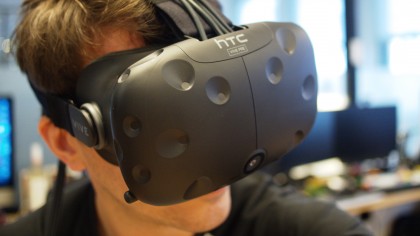
I achieved this by subjecting myself to the feelings of disassociation, anxiety and paralyzing overwhelmingness that you get when you put on a virtual reality headset on multiple occasions.
So, coming back full circle to the question at hand, will it make you sick?
If you're like me the answer is, at first, it might. Your body isn't used to feeling disconnected to the visual stimuli it's receiving. Even if you game for hours and hours per day, you still are sitting in the real world, periodically removing your gaze from the television screen to look at your cellphone or interact with another human being. In virtual reality, the only thing you ever see is the screen and the objects on it.
The good news is, as long as you're playing games that are designed well and do everything they can to minimize screen jitter, you should start to develop a tolerance quickly.
Extended use: a double-edged sword
Another long-held belief that I gave up after owning the Vive for two weeks is that the maximum amount of time someone can spend in virtual reality is 30 minutes.
During the two-week review period, I easily spent two or three hours a day inside the headset. A vast majority of those sessions lasted more than an hour and some tallied closer to two and three. Usually these long hauls involved more than one game – I'd spend 30 minutes playing The Lab, before playing Space Pirate Simulator, Ninja Trainer or Water Bears – but, if there were longer experiences available, I could have seen myself dedicating the same amount of time solely to a single experience.
These longer experiences have gradually made their way to VR platforms since the HTC Vive launched, and as you get used to virtual reality, there's every chance you'll be able to stick it out for hours at a time.
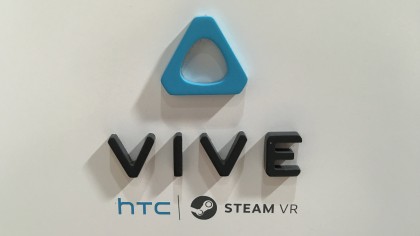
The second problem is that, while I enjoyed every second I spent in virtual reality, the transition of coming back to the real world was one that I found especially difficult. Without dramatizing the emotions, I felt as though I wasn't all there when I took off the helmet. The closest feeling I can pick out is the one where you look at yourself in the mirror and don't really understand the person looking back at you.
You'll still be you, but it won't feel like you at first.
Like playing a regular video game on a 2-D screen, you'll still get image burn-in (called the Tetris Effect) but, at least for me, I also had the slight outline of faint blue lines from Chaperone mode hanging in the background of my vision long after I'd taken off the visor.
These side-effects aren't something that concerns me and I'll keep to my habits of extended use after I'm done writing this review. I've played video games on CRT TVs long enough to know that, while strange, these secondary effects do fade in time without leaving behind permanent damage.
The future of Vive and VR in general
I hope, by this point in the review, I've imparted a modicum of my excitement about the HTC Vive and the experiences it can provide.
What's amazing is that, even though I feel like I've covered the product extensively in the last 3,000 or so words, there are still four or five more features that the HTC Vive is capable of that no one has talked about and no developer has even begun to touch.
In no particular order, they include multiplayer gaming, videos in virtual reality, using the front-facing camera for augmented reality games, integrating the headset with your cellphone to enable texts and calling without taking off the headset, and using the cameras and your headphones' microphone to virtually meet up and chat with other players through SteamVR.
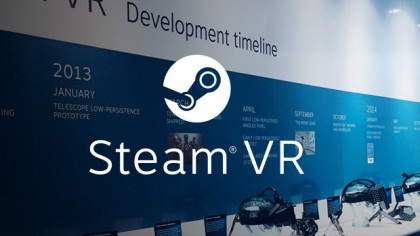
Some of these features may well come down the pipe in the future but they're not quite there yet (or at least nowhere near where they could be). As good as the HTC Vive is, there are still areas where we can see room for improvement.
Maybe the developers didn't want to be intrusive or tell you how to use your new investment. Maybe the headset is just more powerful than developers are creative at this point. Or maybe I've just missed a feature or prompt that fell in between the cracks.
In any event, I view these potential features more with excitement and less with disappointment. I can't wait until Valve finds a way to show off videos made in virtual reality or finds some way to enable multiplayer between two people using HTC Vives.
More games would be great, don't get me wrong, but these are core functions of the headset that – as of right now – are completely going unused or are being used in very minimal ways. (The front-facing camera, for example, can be turned on and off to see how close you are to objects should you feel the Chaperone isn't quite right.)
In addition to the weight and cost of the headset, these are all areas of improvement or new features that I see HTC and Valve working on over the course of the next few years before the inevitable sequel.
I hate to be the bearer of bad news but, until you try it for yourself at a friend's house or in your own living room, you can't possibly predict how much you'll enjoy the HTC Vive. (But, if I had to guess, I'd say the answer will be "a lot.")
If you want a free estimate, however, answer the following questions as honestly as you can: How much time will I dedicate to a technology that requires me to re-arrange my living room every time I want to use it and, more importantly, how much do I trust that developers will continue to support the Vive down the road?
One of those factors is entirely out of your hands. The other requires a fair bit of honesty with yourself. If you don't plan on digging deep into the software and buying loads of interesting, experimental games, then the Vive isn't for you.
However, if you have a positive response for both questions, then it's a safe bet you'll enjoy this truly astounding piece of kit.
At the heart of this experience is excellent hardware and software. A 110-degree field of view means that games will feel more natural, and a larger area to walk around in will keep you from feeling restrained or claustrophobic in your new virtual environment.
This is coupled with two absolutely superb controllers that are shipping with the headset. And sitting just below everything else is Steam, the trusty marketplace of PC gaming that has supplied millions of gamers with software for the past decade. The infrastructure of this platform is as solid here as it's like to get.
Admittedly, this level of perfection isn't without a price, though one that has been recently lowered. You'll need to plonk down $499 / £499 (about AU$615), which is less expensive than the $800 / £689 / €899 you originally had to pay.
But the costs don't stop there. If you want the minimum recommended specs, it'll cost you another few hundred for the Nvidia GTX 970 or AMD 290 (and potentially a whole new PC to house it), which isn't cheap. Then you'll need a space big enough to fully enjoy your new escape from reality which, if you live in a place like San Francisco, London or New York, can be the most expensive part. Of course you can enjoy most games in smaller spaces, but in doing so you're freely giving away the Vive's biggest advantage: virtual space.
We liked
Nearly everything. The Vive remains the best virtual reality headset on the market, bar none. The fact that it allows for room-scale virtual reality should sell it alone, but the fact that it does so in a way that's more believable and fluid than other headsets handle seated play puts the nail in the coffin.
Add to that the two incredibly intuitive controllers that ship with the unit itself on day one, and a library of games that seems to be growing in size at an uncontrollable rate and you have a wildly compelling package at any price.
We disliked
While the HTC Vive used to be prohibitively expensive at $800 / £689 / €899, that has come down significantly. But the question is: is it too little, too late, considering Oculus Rift has had a much lower price for much longer?
Neither HTC nor Oculus release sales figures, so we can't know how many units are actually sold. But HTC Vive is essentially playing catch up with its new lower price, rather than setting the trend.
It's also important to remember that experiences vary based on the hardware you're using. If games run lag-free on a friend's computer, but run like a terrible molasses seizure on yours, don't blame the headset.
While it's not necessarily a negative, the onus now is on developers to leverage the technology and push VR forward. Valve and HTC have enabled a realm of new experiences possible but, what scares me, is that all this technology may fall victim to novelty that will wear off, turning an expensive headset into nothing more than a companion for the Wii that sits in our closets collecting dust.
Final verdict
Putting fears of abandonment aside, HTC created something amazing with the Vive, and that's been refined in the final consumer iteration of the hardware.
It's more immersive than the competition thanks to the ability to walk around in the space, and the reduction of wires from the base stations and controllers is hugely welcome. Gaming using this, even with short demos and incomplete games, feels like the future, and I can't wait to try a dozens more titles using the headset.
Many will wish the resolution was a tad better, that the price was a lower or that the headset fitted them better, but will appreciate that it's too early in the VR game for expectations of perfection. It's a balancing act between performance, size, resolution and price, and HTC seems like it's exactly where it needs to be to deliver on all fronts.
Pure and simple, the HTC Vive is awesome. Virtual reality is amazing. It's the beginning of a new format that isn't constrained to a 16 x 9 or 21 x 9 screen. In many ways, the HTC Vive and the Oculus Rift are similar to the watching the first step on the moon or the train coming out of the screen. They're pure, objective proof that entertainment isn't done evolving.
0 comments:
Post a Comment